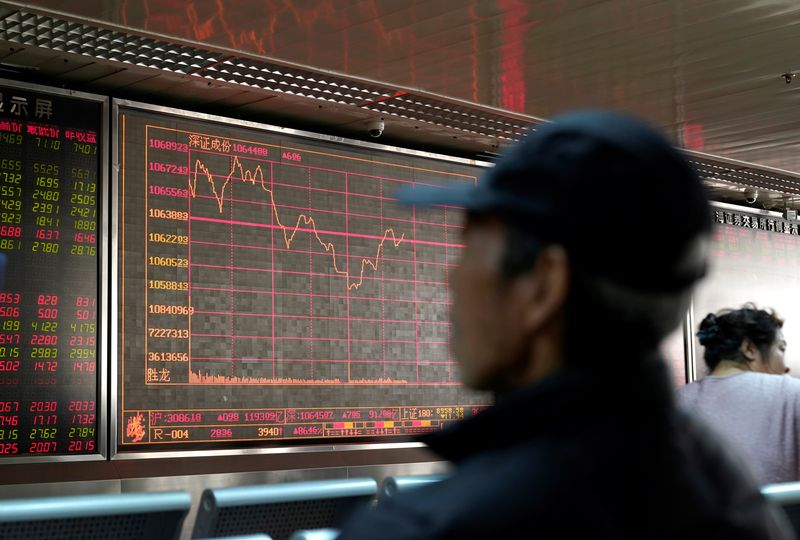
© Reuters. An investor looks at a stock quotation board at a brokerage office in Beijing, China January 3, 2020. REUTERS/Jason Lee/File photo
By Wayne Cole
SYDNEY (Reuters) – Asian shares got off to a subdued start on Monday as markets braced for a raft of Chinese economic data that could well underwhelm, while earnings season picks up steam with Tesla (NASDAQ:) on the docket.
The Chinese economy is forecast to have grown just 0.5% in the second quarter, though the annual pace will be flattered by base effects at a predicted 7.3%.
Retail sales, industrial output and urban investment are all expected to show slowing growth, which is why markets are counting on Beijing to unveil more stimulus measures soon.
Figures out over the weekend showed China’s new home prices were unchanged in June, the weakest result this year.
The risk of even softer outcomes kept MSCI’s broadest index of Asia-Pacific shares outside Japan down 0.2%, though that follows a 5.6% rally last week.
was closed for a holiday, though futures were trading near flat.
and Nasdaq futures were both down 0.2%, but that followed hefty gains last week.
Tesla is the first of the big tech names to report this week, while a busy earnings schedule includes Bank of America (NYSE:), Morgan Stanley (NYSE:), Goldman Sachs (NYSE:) and Netflix (NASDAQ:).
Data on U.S. retail sales are expected to show a rise of 0.3% ex-autos, continuing the slower trend but solid enough to fit into the market’s favoured soft-landing theme.
“We continue to look for a modest contraction to take hold toward the end of the year, but the path to a non-recessionary disinflation is starting to look more plausible,” said Michael Feroli, an economist at JPMorgan (NYSE:).
“We expect Fed officials cheered the latest inflation developments, but declaring victory with sub-4% unemployment, and over 4% core inflation, would be reckless.”
PRICED FOR 2024 POLICY EASING
As a result, markets still imply around a 96% chance of the Fed hiking to 5.25-5.5% this month, but only around a 25% probability of yet a further rise by November.
They have also priced in at least 110 basis points of easing for next year, starting from March, which saw two-year bond yields down 18 basis points last week.
That predicted policy easing is considerably more aggressive than what is priced in for the rest of the developed world, a major reason the U.S. dollar has turned tail.
The dollar has steadied somewhat at 138.75 yen, from a trough of 137.25, but that follows a loss of 2.4% last week. The euro was firm at $1.1223, having also surged 2.4% last week to clear its former top for the year at $1.1096.
Sterling stood at $1.3091, having risen 1.9% last week, with investors anxiously awaiting UK inflation figures later in the week where another high result would add to the risk of further sizable rate hikes.
The hovered at 99.989, after shedding 2.2% last week.
The drop in bond yields was underpinning non-yielding gold at $1,952, after boasting its best week since April. [GOL/]
Oil prices have also been supported by cuts in OPEC supply, seeing crude gain for three weeks in a row before running into profit taking. [O/R]
Early Monday, was off 58 cents at $79.29 a barrel, while fell 55 cents to $74.87.





